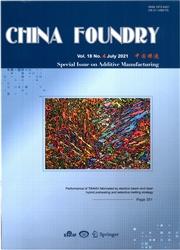环形电磁搅拌制备A356流变铸造半固态浆料的力学性能及微观组织演变
IF 2.3
3区 材料科学
Q2 Materials Science
引用次数: 0
摘要
目前,有一种有效的技术来制备半固体浆料的流变铸造工艺似乎是一个必不可少的要求。采用三相环形电磁搅拌(A-EMS)技术,在不同条件下制备了A356铝合金半固态浆料。研究了搅拌电流、浇注温度和搅拌时间对微观组织演变、平均粒径、形状因子和固相分数的影响。采用滴重装置,在最佳条件下将制备好的半固态浆料注入阶梯模腔,进行了流变铸造工艺。对零件的填充行为和力学性能进行了研究。结果表明,在搅拌电流为70 a、熔体浇注温度为670℃、搅拌时间为30 s的条件下,获得的最佳半固态浆料为平均粒径为~ 27µm、形状因子为~ 0.8的球状细颗粒。在此条件下,在470℃的模具预热温度下,阶梯模腔被完全填充。通过减小步长厚度和模具预热温度来提高硬度。此外,在较低的模具预热温度下,拉伸性能得到改善。断口形貌复杂,为典型的韧性断裂。本文章由计算机程序翻译,如有差异,请以英文原文为准。
Mechanical properties and microstructural evolution of rheocast A356 semi-solid slurry prepared by annular electromagnetic stirring
Nowadays, having an effective technique in preparing semi-solid slurries for rheocasting process seems to be an essential requirement. In this study, semi-solid slurry of A356 aluminum alloy was prepared by three-phase annular electromagnetic stirring (A-EMS) technique under different conditions. The effects of stirring current, pouring temperature and stirring time on microstructural evolution, mean particle size, shape factor and solid fraction were investigated. The rheocasting process was carried out by using a drop weight setup and to inject the prepared semi-solid slurry in optimal conditions into the step-die cavity. The filling behavior and mechanical properties of parts were studied. Microstructural evolution showed that the best semi-solid slurry which had fine spherical particles with the average size of ∼27 µm and a shape factor of ∼0.8 was achieved at the stirring current of 70 A, melt pouring temperature of 670 °C, and stirring time of 30 s. Under these conditions, the step-die cavity was completely filled at die preheating temperature of 470 °C. The hardness increases by decreasing step thickness as well as die preheating temperature. Moreover, the tensile properties are improved at lower die preheating temperatures. The fracture surface, which consists of a complex topography, indicates a typical ductile fracture.
求助全文
通过发布文献求助,成功后即可免费获取论文全文。
去求助
来源期刊

China Foundry
工程技术-冶金工程
CiteScore
2.10
自引率
25.00%
发文量
1646
审稿时长
3.0 months
期刊介绍:
China Foundry, published bimonthly to a worldwide readership, mainly reports on advanced scientific and technical achievements, applied technology, production successes, management and leadership, recent developments and industry information in the foundry field. Coverage encompasses all casting technologies and includes, but is not limited to, novel and net shape casting technologies; casting alloy design and modification; control of nucleation, solidification and microstructure & mechanical properties; computer aided design; rapid prototyping; mold making, mold materials and binders; mold and gating design; melting and liquid-metal treatment and transport; modeling and simulation of metal flow and solidification; post-casting treatments; quality control and non-destructive testing; process automation and robotics; and safety and environmental issues.
 求助内容:
求助内容: 应助结果提醒方式:
应助结果提醒方式:


